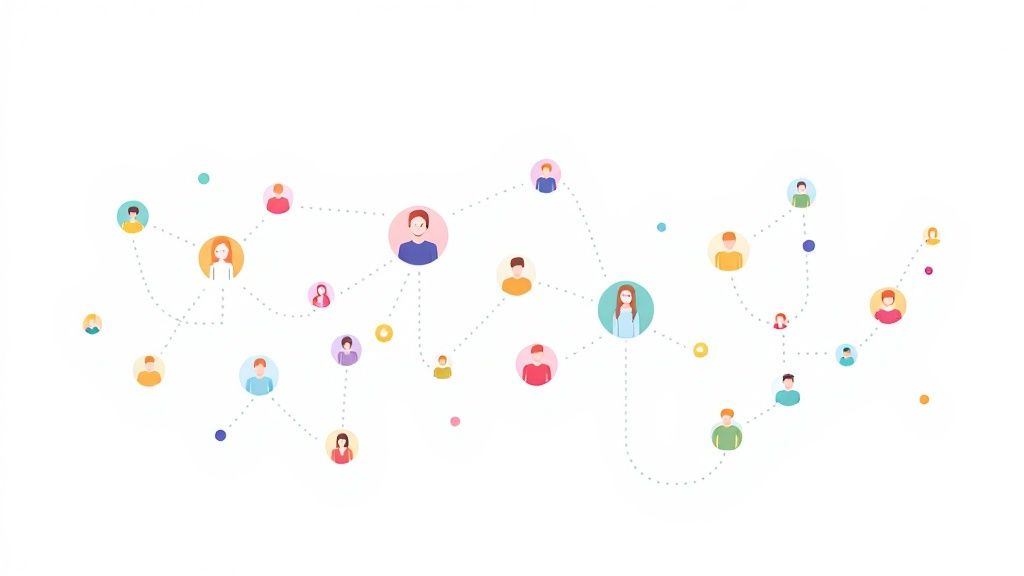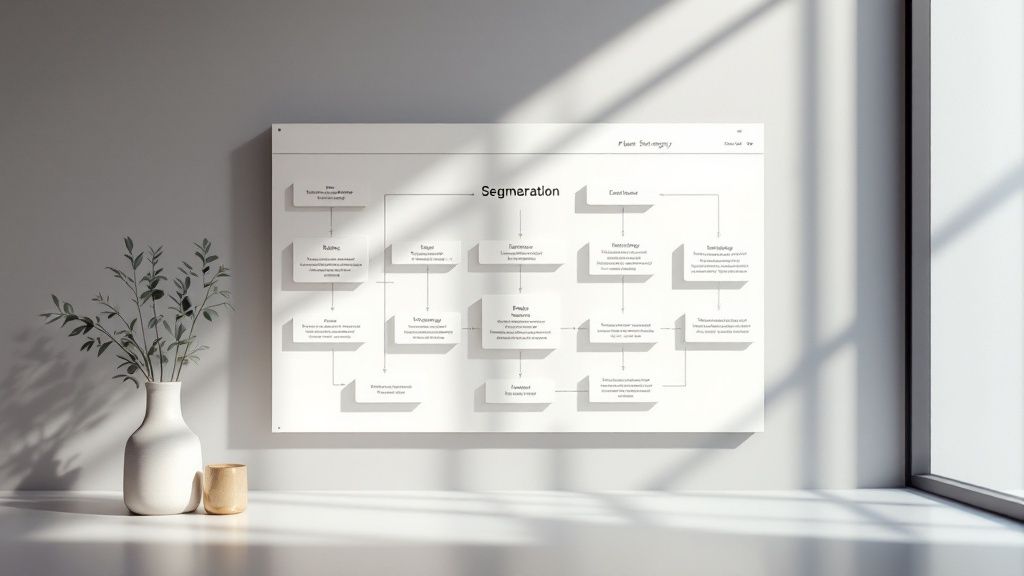How to Segment Customers: Smart Growth Tactics
March 22, 2025

Mastering the Art and Science of Customer Segmentation
Customer segmentation isn't simply about dividing your audience into groups. It's about gaining a deep understanding of your customers to craft truly personalized experiences. This shift from generic marketing to targeted engagement lies at the heart of successful strategies today. It allows businesses to move away from the outdated "one-size-fits-all" approach and tailor messages that resonate with specific customer groups. This focused method builds stronger customer relationships and ultimately leads to better business results.
Why Segment Your Customers?
The core principle of customer segmentation is the recognition that your audience is diverse. Different customers have different needs, motivations, and behaviors. For instance, a first-time buyer will likely have different expectations than a loyal, returning customer. Recognizing these differences allows you to fine-tune your marketing for maximum impact. This resonates far more effectively than a generic message sent to everyone. Moreover, understanding your customers' unique motivations enables you to offer more relevant products and services, boosting customer satisfaction and sales.
The Impact of Personalization
Customer segmentation has become a critical strategy for businesses to improve customer experiences and boost revenue. In fact, 80% of audiences prefer to do business with brands that personalize their experience, highlighting the importance of segmentation in creating tailored marketing communications. Find more detailed statistics here. This emphasizes the need to understand effective customer segmentation. Segmenting your audience allows you to deliver the right message, to the right person, at the right time. This targeted approach not only increases marketing effectiveness but also strengthens customer loyalty. As a result, your marketing budget is used more efficiently, reaching those most likely to convert. You might be interested in: How to master customer segmentation strategies.
Beyond Basic Demographics
While demographic data such as age, location, and income remain relevant, effective customer segmentation goes beyond these basic factors. Modern segmentation strategies delve into behavioral patterns, psychographic profiles, and even predictive analytics. This gives you insights not only into who your customers are but also into how they interact with your brand and what they are likely to do in the future. This deeper understanding allows you to anticipate customer needs and proactively address them, creating a truly personalized and engaging customer experience. By analyzing purchasing behavior, website interactions, and responses to marketing campaigns, you can identify high-value customers and develop strategies to nurture these key relationships.

Demographic Segmentation: Beyond the Basics
Demographic segmentation is fundamental to understanding your customer base. Basic demographics like age, gender, income, and education are a good starting point, but effective segmentation requires a deeper dive. It's about understanding not just who your customers are, but why they buy what they do. Two customers with the same age and income could have drastically different buying habits depending on their lifestyle, profession, or family situation.
This image provides a visualization of combining demographic data with other segmentation methods.

Refining Your Demographic Data
The real power of demographic segmentation comes from combining different factors. Instead of looking at each variable separately, consider how they interact and influence each other. This helps uncover hidden opportunities and create more specific customer segments. Demographic segmentation is a popular technique, especially for Business-to-Consumer (B2C) companies. It's often the most effective way to understand customer groups with shared traits. Learn more about customer segmentation models. This approach allows you to tailor your message to specific groups, making your marketing more efficient.
Targeting Specific Customer Needs
Understanding which demographic variables matter most to your industry is essential. Income may be key for luxury goods, while age and family status might be more important for children's products. This targeted approach helps you refine messaging and product development to directly address specific customer needs. For example, a Shopify store owner using Checkout Links can segment customers by their purchase history, offering personalized recommendations and exclusive deals to those who regularly buy from certain product categories.
To further illustrate the application of demographic variables in marketing, let's take a look at the table below. It provides a comprehensive overview of key demographic variables, their data points, marketing applications, and industry examples.
Demographic Segmentation Variables: A comprehensive overview of key demographic variables and their marketing applications
| Demographic Variable | Data Points | Marketing Applications | Industry Examples |
|---|---|---|---|
| Age | Age range (e.g., 18-24, 25-34), Generation (e.g., Millennial, Gen Z) | Targeted advertising, product development, content creation | Streaming services offering different subscription plans based on age; Clothing retailers designing lines for specific age groups |
| Gender | Male, Female, Other | Product design, messaging, channel selection | Cosmetics companies creating gender-specific products; Clothing brands offering different styles for men and women |
| Income | Income brackets (e.g., $25,000-$50,000, $50,000-$75,000), Socioeconomic status | Pricing strategies, product positioning, channel selection | Luxury car brands targeting high-income earners; Budget retailers focusing on value-conscious consumers |
| Education | Highest level of education attained (e.g., high school, bachelor's degree, master's degree) | Content complexity, messaging tone, channel selection | Online education platforms offering courses tailored to different education levels; Financial institutions creating educational materials for varying levels of financial literacy |
| Family Status | Marital status, number of children, presence of children in the household | Product development, messaging, promotional offers | Baby product companies targeting new parents; Family restaurants offering discounts for families with children |
| Occupation | Job title, industry, employment status | Targeted advertising, content creation, networking opportunities | Professional networking sites connecting individuals within specific industries; Software companies offering specialized tools for different occupations |
As you can see from the table, understanding and utilizing these demographic variables can significantly impact your marketing strategies and overall business success. Each variable provides valuable insights into customer behavior and preferences, allowing for more personalized and effective marketing efforts.
Avoiding Overgeneralization
One common mistake in demographic segmentation is overgeneralization. While grouping customers by shared traits is useful, avoid making assumptions about individual preferences solely based on group affiliation. This is where tools like Checkout Links can be extremely helpful. They let you personalize offers and promotions at the individual level, even within broader demographic segments. This personalized approach makes your messaging feel relevant, leading to stronger customer relationships.
Building a Scalable Framework
Building adaptable and scalable segmentation frameworks is essential for lasting success. Your strategy should be flexible enough to adapt to changing market conditions and evolving customer behavior. This means regularly reviewing and updating your segments, adding new data points, and using tools like Checkout Links to automate personalized messages. A dynamic segmentation model keeps your marketing relevant and effective, driving significant results. It also helps you spot new trends and adapt your strategies, maximizing your return on investment.
Behavioral Segmentation: Turning Actions Into Insights
While demographic data tells you who your customers are, behavioral segmentation reveals what they do. This is a crucial difference for effective marketing. Behavioral segmentation focuses on analyzing customer actions, providing valuable insights into purchase patterns, product usage, and overall engagement. By understanding these behaviors, you can anticipate customer needs, personalize messaging, and ultimately drive conversions.
Understanding Customer Actions
Analyzing purchase patterns is fundamental to behavioral segmentation. This involves examining the frequency of purchases, average order value, and the specific products or services customers buy. For example, identifying customers who regularly purchase high-value items allows you to create exclusive offers and loyalty programs for this valuable segment.
Understanding engagement metrics like website visits, email click-through rates, and social media interactions offers a deeper understanding of how customers interact with your brand. This information helps optimize your marketing channels and content to resonate better with specific segments.
Identifying Key Behavioral Segments
Behavioral segmentation helps you identify several key customer groups. High-value customers, for example, are identifiable by their frequent purchases and high average order value. These customers deserve special attention and personalized communication to cultivate long-term loyalty.
Understanding the behavior of at-risk customers allows you to implement proactive measures to prevent them from leaving. If a customer hasn't purchased recently or stopped engaging with your emails, targeted offers or re-engagement campaigns can help win them back.
Behavioral segmentation also helps you uncover untapped opportunities by identifying customer groups who might be receptive to new products or services based on their past actions. This information is especially valuable for product development and targeted marketing initiatives. Behavioral segmentation is particularly useful in e-commerce because it focuses on how customers interact with a brand's products or services. Analyzing purchase behavior, website interactions, and responses to marketing campaigns helps create targeted segments. Explore this topic further.

Mapping the Customer Journey
Mapping the customer journey is a vital step in behavioral segmentation. This involves visualizing the steps customers take, from initial awareness to purchase and beyond. By understanding this journey, you can identify natural segmentation points and tailor your marketing accordingly.
For instance, using tools like Checkout Links, you can create personalized shoppable links for specific stages of the customer journey, such as abandoned cart emails with pre-filled carts and tailored discounts. This simplifies the purchase process and encourages conversions.
Implementing Behavioral Insights
Implementing behavioral segmentation doesn't require extensive resources. Tools like Checkout Links enable Shopify merchants to use these insights effectively. By creating customized shoppable links for different customer segments, you can personalize offers, automate email campaigns, and track the performance of your segmented marketing.
This granular approach allows you to optimize your marketing spend and maximize your ROI. Whether it's following up on abandoned carts or sending personalized product recommendations, Checkout Links provides the tools to turn behavioral data into actionable campaigns. This lets you connect with customers in a more meaningful way, ultimately driving customer lifetime value and reducing acquisition costs.
Psychographic Segmentation: The Emotional Connection
While demographics and behavior provide valuable data, psychographic segmentation delves into the why behind customer actions. It explores the values, aspirations, and pain points that motivate purchasing decisions. This understanding allows you to connect with customers on an emotional level, fostering deeper engagement and brand loyalty.
Two customers might share similar demographics and buying habits, but their motivations could differ significantly. One might prioritize sustainability, while another is driven by status. Psychographic segmentation helps uncover these nuances.

Research Techniques for Uncovering Motivations
Several research techniques can uncover these psychographic insights:
- In-depth interviews: These provide rich qualitative data, exploring customer motivations in detail.
- Social listening: This offers a broader perspective by analyzing online conversations and trends.
- Surveys: Even simple surveys can be powerful tools, especially when combined with other methods.
These techniques don't need to be complex. Even a few well-structured interviews can provide valuable information for smaller businesses.
Building Rich Customer Personas
Psychographic insights form the foundation for creating rich customer personas. These go beyond basic demographics, painting a picture of your ideal customer's lifestyle, values, and motivations. This understanding helps tailor messaging and offers to resonate personally.
For example, a Shopify store selling eco-friendly products can use psychographic segmentation to identify customers prioritizing sustainability. Using Checkout Links, they can create targeted shoppable links featuring products and messaging aligned with those values.
Emotional Connections Through Psychographic Insights
Understanding customer motivations transforms messaging from generic to compelling. This emotional connection fosters stronger relationships and increases brand loyalty.
Consider a brand selling fitness equipment. Instead of focusing on product features, they can tailor messaging to resonate with customers' desires for a healthier lifestyle or aspirations to achieve specific fitness goals. This targeted approach makes the brand more relatable and increases conversion likelihood.
Navigating Privacy and Data Collection
While psychographic segmentation offers advantages, it's crucial to navigate privacy ethically.
- Be transparent about data collection and usage.
- Focus on gathering information relevant to business objectives.
- Avoid collecting unnecessary data.
Prioritizing customer privacy and transparency builds trust and strengthens customer relationships. Tools like Checkout Links can assist by enabling personalized marketing without extensive data collection. You can segment customers based on past purchases and offer tailored product recommendations without collecting sensitive information. This enhances the customer experience while respecting privacy.
Predictive Segmentation: Anticipating Customer Needs
Predictive segmentation moves beyond simply understanding what your customers are doing now. It focuses on anticipating their future needs and actions. This powerful approach, once the exclusive domain of data science teams, is now within reach for all marketers. It empowers businesses to proactively meet customer needs and fine-tune marketing strategies for maximum impact.
Identifying High-Value Customers
One of the key benefits of predictive segmentation is the ability to identify your most valuable customers before they even become big spenders. By carefully analyzing early engagement patterns and purchase behavior, you can pinpoint customers who are likely to increase their lifetime value. This allows you to concentrate your marketing efforts on nurturing these promising relationships from the outset.
For example, Shopify merchants can use Checkout Links to create targeted welcome emails for new customers. Offering personalized discounts in these initial interactions can further incentivize customers on their path to becoming high-value shoppers.
Detecting Early Warning Signs of Churn
Predictive segmentation also provides a crucial early warning system for potential churn. By analyzing data for indicators like decreased engagement, declining purchase frequency, or negative feedback, you can identify at-risk customers. Addressing these warning signs early, through personalized outreach, targeted offers, or improved customer support, is vital for customer retention. This proactive approach shifts the focus from reactive damage control to proactive relationship management. Learn more about creating personalized recovery links for abandoned carts and crafting targeted email campaigns here.
Predictive analytics uses historical data, machine learning, and statistical algorithms to forecast future customer behavior. This can be incredibly helpful for businesses seeking to identify and cater to their high-value customers. Learn more about customer segmentation analytics here.
Anticipating Changing Customer Needs
Customer needs are in constant flux, influenced by everything from shifting market trends to significant life events. Predictive segmentation helps you stay ahead of these changes. By analyzing purchasing patterns, website interactions, and responses to marketing campaigns, you can anticipate shifts in demand. This allows you to proactively adjust your products, services, and messaging, ensuring continued relevance and strengthening customer relationships.
Implementing Predictive Segmentation Without Technical Overhauls
You don't need a massive technical overhaul to integrate predictive segmentation into your current marketing systems. Solutions like Checkout Links provide a seamless way to implement these advanced strategies. You can segment customers based on predicted behavior, automate personalized email campaigns, and track the performance of your efforts. This allows you to harness the power of data science, even without a dedicated data science team.
Choosing the Right Predictive Modeling Approach
Different business objectives require different predictive modeling techniques. Understanding these nuances is key to selecting the most effective approach for your specific needs. This might involve consulting with data analysis experts or leveraging pre-built predictive models within your existing marketing platforms.
Data requirements are another important factor. Some models require extensive historical data, while others can perform well with smaller datasets. The ideal model depends on the data you have available and the goals you want to achieve.
The following table, "Segmentation Methods Comparison", compares different segmentation approaches, highlighting their benefits and implementation difficulty. It offers a clear overview of the various options available, allowing you to choose the best fit for your business.
| Segmentation Type | Primary Benefits | Data Requirements | Implementation Complexity | Best For |
|---|---|---|---|---|
| Demographic | Simple, readily available data | Basic demographic information (age, gender, location) | Low | Broad targeting, initial segmentation |
| Behavioral | Insights into customer actions and preferences | Website analytics, purchase history, engagement metrics | Medium | Personalized marketing, targeted campaigns |
| Psychographic | Understanding customer motivations and values | Surveys, interviews, social listening | Medium-High | Building brand loyalty, emotional connection |
| Predictive | Anticipating future behavior and needs | Historical data, machine learning algorithms | Medium-High | Proactive customer retention, identifying high-value customers |
By carefully considering these factors, you can select a predictive segmentation approach that provides actionable insights and integrates smoothly with your current infrastructure.
Measuring and Optimizing Your Segmentation Strategy
Creating customer segments is only the first step. The real value lies in consistently measuring and refining your strategy to ensure tangible results. This involves understanding relevant metrics, establishing effective tracking, and using techniques like A/B testing.
Key Metrics for Measuring Segmentation Success
Different segmentation approaches require different metrics. For demographic segmentation, you might track conversion rates by age group or location. Behavioral segmentation relies on metrics like purchase frequency, average order value, and customer lifetime value.
Psychographic segmentation is harder to quantify, but you can measure engagement with content tailored to specific values or interests. With predictive segmentation, metrics like churn rate and customer lifetime value are especially important.
Tracking Systems and A/B Testing
Robust tracking is essential, but you don't need complex data science expertise. Tools like Google Analytics combined with platforms like Checkout Links allow you to track key metrics for each segment. For more information on email list segmentation, check out this helpful resource: How to master email list segmentation.
A/B testing is crucial for validating segment-specific campaigns. By testing different messaging, offers, and channels, you can identify what resonates with each segment and continuously optimize your approach.
Maintaining Dynamic Segmentation Models
Successful companies understand that customer behavior is dynamic. Markets change, preferences evolve, and new trends emerge. Your segmentation strategy must adapt to these shifts. Regularly review and update your segments, incorporate new data, and refine your criteria to ensure your model stays relevant and effective. Checkout Links supports this dynamic approach by enabling quick adjustments to personalized offers and messaging based on evolving customer behavior.
Identifying Warning Signs and Refreshing Your Segments
Several warning signs indicate your segments need refreshing. Declining engagement, reduced conversion rates, or increased churn within a specific segment suggest your targeting is becoming less effective. This could be due to changing customer preferences, market shifts, or outdated data. Regularly analyzing segment performance and proactively addressing these warning signs is crucial for a successful segmentation strategy.
Enhancing Segmentation Sophistication
Gradually increasing the complexity of your segmentation is recommended. Start with basic demographics and behavioral data, then progressively incorporate psychographic and predictive elements. This allows your team to adapt to new techniques and avoids data overload. Checkout Links facilitates this gradual enhancement. You can begin with simple segmentation based on purchase history and progressively incorporate more sophisticated criteria as your needs evolve. This phased approach maximizes the benefits of customer segmentation without significant resource investment.
Ready to transform your email marketing and automation with personalized, shoppable links? Start your free trial of Checkout Links today and see the power of segmented marketing in action! Get started now!
 Checkout Links
Checkout Links



